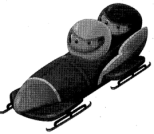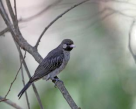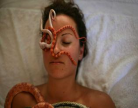1 . With the world’s attention on vaccines (疫苗), now feels like a good moment to sing the praises of an often forgotten contribution to their development. Three hundred years ago this month, Lady Mary Wortley Montagu got her daughter inoculated (接种) against smallpox, making her child the first person in the West to be protected in this way. Without Montagu’s willingness to adopt a practice she had learned from other cultures, the introduction of vaccines around 80 years later would never have taken place.
Montagu first witnessed inoculation when she accompanied her husband to Turkey in 1717. Inoculation had started in Asia, probably in China, as early as the 10th century AD. Montagu observed how older women in Turkey took a tiny amount of pus (脓) from a person with smallpox. They then used needles to make cuts on people’s wrists and ankles and added the pus to their bloodstream. This helped people gain immunity from future infection.
Like other visitors to the country, Montagu took steps to ensure that her son was inoculated in Turkey. This worked well, but she knew that trying it in England would be far more challenging. Inoculation performed by unlicensed amateurs would threaten doctors’ professional standing and potentially rob them of valuable income. Churchmen also disagree with the practice, as they saw it as going against nature.
Back in England, Montagu observed the increased severity of smallpox infections. Eventually, in April 1721, she decided to use the Turkish practice to have her daughter inoculated, because she believed that the rewards would outweigh the risks. After a safe time had passed following the inoculation, Montagu allowed doctors to examine her daughter.
Doctors in Britain gradually accepted the practice. About so years later, a pioneering physician found smallpox vaccines to destroy smallpox completely. As early as last century, academics argued that Montagu was no more than an enthusiastic amateur. In truth, she made a vital scientific contribution towards finding the cure for smallpox.
1. What is the second paragraph mainly about?| A.The origin of smallpox inoculation. |
| B.Montagu’s first access to inoculation. |
| C.The benefits from smallpox inoculation. |
| D.Turkish women’s invention of inoculation. |
| A.it was against human nature | B.it might harm doctors’ interests |
| C.it was beyond doctors’ abilities | D.it might shake churchmen’s belief |
| A.The increased severity of smallpox infections. |
| B.A physician’s discovery of smallpox vaccines. |
| C.The result of Montagu’s daughter’s inoculation. |
| D.Montagu’s focus on its rewards rather than its risks. |
| A.An unsung hero | B.No limit to creation |
| C.Development of vaccines | D.A historic medical innovation |

Shooting down an ice-covered track, a bobsled(大雪橇)can go faster than 80 miles an hour, and riders can feel force five times stronger than the pull of gravity. A race can be won or lost by one hundredth of a second. How do bobsleds go faster than cars on a highway? The answer is a combination of athletics and science.
At the start of a race, the crew push their sled, building up speed before they jump in for the ride. For months before the race, the crew have built up power in their legs. The push is the crew's only chance to add speed. All other work goes into keeping friction and drag(摩擦力和阻力)from slowing the sled down.
The design of the sled's runners(滑板)reduces their friction with the ice. The friction of a moving runner melts a little ice right under the runner, and the runner rides on that thin layer of water. The runners are rounded on the bottom. Runners that are too flat may not melt enough ice for fast ride. Runners that are too round may become too warm, softening the ice and slowing the sled down. No amount of rounding is perfect for all races because the hardness of the ice depends on the weather on race day.
Bobsleds used to be open. The riders did not sit inside a hull(外壳). As the crew sped down the track,the air would create drag. Today, a sled's hull reduces drag by splitting the air in front of the sled and making it flow smoothly along the slides. As with the runners,strict rules apply to the hull. For example,no team may add any part that would create helpful air currents.
Reducing friction and drag creates another challenge: high speeds. “The faster the sleds car travel on the run, the more thrilling the race,” one research team wrote. “But the track must not be too fast: he crew still need to be able to reach the bottom safely.”
1. What's the text mainly about?| A.The shape of the sled. | B.The design of the runners. |
| C.The safety rules applying to the sled. | D.The elements relating to the sled's speed |
| A.Proper amount of melted ice is needed for a fast ride. |
| B.The rounder the runners are, the faster the sled goes. |
| C.Thin layer of water would drag the runners backward. |
| D.A sled's movement has nothing to do with weather. |
| A.It's comfortable to sit in. | B.It leads to beneficial air flow. |
| C.It helps to create a safe ride. | D.It's free from strict rules. |
| A.Safety is the most important. | B.Keeping high speed is difficult. |
| C.Riders' desire to win is understandable. | D.The crew's cooperation is necessary. |
3 . Experts are warning about the risks of extremely picky(挑剔的)eating after a teenager living on a diet of chips and crisps developed lasting sight loss. Eye doctors in Bristol cared for the 17-year-old after his sight had gone to the point of blindness. Tests showed he had serious vitamin deficiency(缺乏). Dr. Denize Atan, who treated him at the hospital, said, “His diet was basically a portion of chips from the local fish and chip shop every day. He also used to snack on crisps and sometimes white bread and ham, and not really any fruit and vegetables.”
The teenager saw his doctor at the age of 14 because he had been feeling tired and unwell. At that time he suffered from vitamin B12 deficiency, but he did not stick with the treatment or improve his poor diet. Three years later, he was taken to the Bristol Eye Hospital because of progressive sight loss.
He was not overweight or underweight, but he had lost minerals from his bones, which was really quite shocking for a boy of his age. In terms of his sight loss, he met the standards of being blind. “He had blind spots right in the middle of his sight,” said Dr Denize Atan, “That means he can’t drive and would find it really arduous to read, watch TV or recognize faces.”
Dr Denize Atan said that parents should learn about the harm that can be caused by picky eating, and turn to experts for help. For those who are concerned , she advised, “It’s best not to be anxious about picky eating , and instead calmly introduce one or two new foods with every meal.” She said multivitamin tablets can supplement(补充) a diet, but cannot take the place of eating healthily. “It’s much better to take in vitamins through a varied and balanced diet,” she said, adding that too many certain vitamins , including vitamin A, can be harmful ,“so you don’t want to overdo it.”
1. What does Dr Denize Atan imply in paragraph 1?| A.The diet of the boy is not balanced. |
| B.Fruit and vegetables are rich in vitamins. |
| C.Picky eating is common among teenagers. |
| D.The cause of the boy’s disease is unknown. |
| A.To improve his poor diet. |
| B.To get some help to lose weight. |
| C.To be treated for his discomfort. |
| D.To slow down his progressive sight loss. |
| A.Important. | B.Easy. | C.Necessary. | D.Difficult. |
| A.Reasons why the boy is seriously ill. |
| B.Suggestions for the boy’s family to care for him. |
| C.Advice for parents worried about picky eating. |
| D.Ways of taking in enough vitamins and minerals. |
4 . Chimps use loud calls and gestures to make their feelings known but until now, the exact meaning for individual movements has remained a mystery. Now researchers believe they have translated the key gestures used in the chimp community and identified their intentions for the first time.
From 4,351 gestures, experts were able to identify 66 that are used for 19 specific message meanings, including showing a foot to tell a child they can climb on their back. The researchers were able to narrow down these 66 gestures to 36 that are used intentionally to achieve 15 purposes. The translations were made by Dr Catherine Hobaiter and her colleagues at St Andrews University in Scotland.
Dr Hobaiter used behavior sampling and filmed all recorded cases of gestural communication. Other gestures include stomping their feet to ask another chimp to stop what they are doing, and slapping objects together to ask another to follow them. Of the 19 meanings,17 encouraged interactions to start, or to develop, such as “move closer,” and “change play”. Some of the gestures were found to have more than one meaning. and only 10 of the 66 gestures were used for only a single meaning.
Researchers collected a total of 471 video clips from two social groups of chimps at a shelter near Kinshasa, Democratic Republic of Congo. As well as identifying what the gesture means, they also discovered the technique needed to increase the chances of success.
“Human children use gestures to communicate before they produce their first words, and their earliest gestures typically appear around 10 months of age,” explained the researchers. “In great apes, there is good evidence that language-trained individuals are capable of acquiring and understanding signals, but this is far less clear in their natural communication. ”
1. Chimps slap the objects to____________.| A.tell others to stop what they are doing | B.ask others chimps to join them |
| C.gather other chimps to move closer | D.encourage interactions to start |
| A.Chimps trained in language are good at understanding signals. |
| B.Two social groups of chimps live at a shelter near Kinshasa. |
| C.Language-trained individuals do well in natural communication. |
| D.Chimps’earliest gestures appear around 10 months of age. |
| A.By analyzing causes. | B.By examining differences. |
| C.By making comparisons. | D.By following time order. |
| A.A New Research on Chimps | B.Human Children and Chimps |
| C.Getting the Chimps Trained for Language | D.Translating the Sign Language of Chimps |
5 . A small bowl bought at a yard sale in Connecticut for just $ 35 has been identified as a rare 15th-century Chinese antique.
The blue-and-white bowl was made by China's royal court during the Ming dynasty. It is now expected to sell for up to $500,000, according to Sotheby's auction(拍卖)house in New York, where the auction will take place next month.
The purchase was made last year near New Haven, Connecticut. “I was just hanging around there aimlessly. But when I saw this bowl, I didn't even bargain over the $35 asking price,” the owner said. Shortly after the purchase, he sent photos of the bowl to auction specialists, who identified it as an item of historical significance.
Upon closer inspection, the artifact was found to have originated from the period of Yongle Emperor, who ruled from 1403 to 1424 - a period noted for its distinctive porcelain (瓷器)techniques. It's now valued between $300,000 and $500,000, with the top estimate nearly 14,300 times the amount it was purchased for.
“I was deeply attracted by the techniques. You can see why this bowl is so highly-valued from the very smooth porcelain body, silky glaze(上釉)and special blue coloring, which were never reproduced in later dynasties,” McAteer, an auction specialist, said.
“The Yongle Emperor improved the porcelain techniques and elevated the importance of porcelain from being an ordinary bowl into a true work of art. This small bowl has both practical and artistic value, ”McAteer said.
1. What can we infer about the bowl's owner?| A.He found the bowl by accident. |
| B.He hesitated during the purchase. |
| C.He doubted whether the bowl was real. |
| D.He bought the bowl because it was cheap. |
| A.The blue color on it. | B.The long history it has. |
| C.The people who made it. | D.The unique techniques used. |
| A.Forsaw. | B.Promoted. |
| C.Assessed. | D.Acknowledged. |
| A.An Amazing Bowl | B.A Special Yard Sale |
| C.The Return of Porcelains | D.A Man Making Fortune |
6 . In the world of Chinese archaeology (考古学), a sign of a dig's importance is the sight of Zhou Mingsheng at work. A field technician who has worked at archaeological sites all around China. Master Zhou is credited with the gentlest touch in his profession. Born into a farming family, he is a “national-level craftsman” with a talent for using simple tools to get relics (遗物) that would crumble in other hands, says his current boss, Wang Xu, director of an archaeological site at Shuanghuaishu, a Neolithic (新石器时代的) settlement near the Yellow River in the central province of Henan.
It is not beauty that attracts visitors to Shuanghuaishu. At 5, 300 years old, the settlement is the work of a culture too simple to have left behind many buried treasures. The single most precious find, to date, is a finger-length sculpture of a silkworm. Nor is the setting lovely: an area surrounded by deafening insects, between a highway and two power stations. Rather, the site's importance is historical. For since the birth of Chinese archaeology in the 1920s, it has been inseparable from claims that China has the oldest unbroken civilisation on Earth.
Leading archaeologists say that the site has the right combination of location, age and distinctive cultural elements to be the capital of an early Chinese kingdom. That would make it a bridge between China's written history and the era of the Yellow Emperor, who is said to rule over these central plains almost 5,000 years ago, though many foreign scholars doubt his existence. Chinese media call the site proof of China's 5,000 years of history.
Foreigners complain about a lack of written records, Mr Wang notes. Perhaps they are missing symbols that will one day be understood, for instance in patterned pottery. Outsiders "can't keep using Western standards to apply to Chinese ruins," he argues.
1. What does the underlined word “crumble” in paragraph 1 mean?| A.Result. | B.Break. | C.Wait. | D.Shine. |
| A.It is of great historical significance. | B.It has various precious treasures. |
| C.It has appealing scenery. | D.It is easily accessible. |
| A.Ambiguous. | B.Tolerant. |
| C.Disapproving. | D.Sympathetic. |
| A.Chinese history amazes the world | B.Chinese archaeology catches on |
| C.China follows its tradition | D.China digs its past |
7 . In an incredible display of compassion and kindness, a man from Turkey was spotted trying to warm a pigeon in the most creative way.
Sabahattin Yılmaz was at home one chilly day. After a rain shower had passed, he noticed something landed on the sill (窗台) outside his window—a cold and wet pigeon. The animal was trembling and soaked; it clearly didn’t have the chance to seek shelter before the rain began. Feeling for the poor pigeon, Yılmaz thought of a way to dry him off.
Rather than pick him up and take him inside to warm up, Yılmaz plugged in a hairdryer and used it to dry off the bird. Little did he know that his neighbor captured the whole moment on video. In the video, Yılmaz can be seen leaning out of his window. He was stretching his arm as far as he can so the hot air can reach the pigeon. The bird willingly let the man warm him up, crouching (蹲伏) to let his outer feathers dry.
Yılmaz told the media that he spent about fifteen minutes drying off the bird. He said he had just opened his window when he saw the pigeon around the corner of the sill. He described it as wet and “about to freeze” from the cold and rainy weather.
After fifteen minutes, Yılmaz gave the pigeon birdseed, which he ate happily. However, the bird remained wet still. “I saw that it was still there so I warmed it up again, after the pigeon recovered again, and after eating a good amount of seed, it flew away,” Yılmaz recalled.
He also didn’t know that he was being recorded at the time and that the video was shared online. He simply did it out of the kindness of his heart. “The pigeon is a living creature and deserved to continue living, that is why I did it,” he said.
1. What is the text mainly about?| A.An online video about a pigeon became a hit. |
| B.A man warmed up a wet and cold pigeon. |
| C.A man invented a creative way to help birds. |
| D.A man lives in harmony with a pigeon. |
| A.It was scared and flew away. |
| B.It was annoyed and refused his help. |
| C.It was ready to accept his assistance. |
| D.It was happy to settle in his home. |
| A.A man was filming Yılmaz’s kindness. |
| B.A pigeon was jumping back and forth when dried off. |
| C.Yılmaz was warming a pigeon in a novel way. |
| D.Yilmaz was stretching his arms to catch a pigeon. |
| A.Indifferent but creative. | B.Patient and ambitious. |
| C.Talented but careless. | D.Sympathetic and warm-hearted. |
8 . Just as a hungry brain craves (渴望) food, a lonely brain craves people. A new brain study demonstrates this. After being left alone, it shows people's brains would be activated at the sight of other people. The action was in the same brain region that speeds up when a hungry person sees food.
Livia Tomova, a neuroscientist, who studies how the brain produces mental activities, and her colleagues began this study. They recruited (招募) 40 people. On one day, the participants had to fast—not eat anything at all—for 10 hours. On another day, the same people were placed in a room for 10 hours. They couldn't see anyone. No friends, no family and no social media. They weren't even allowed to check their email. After both days, Tomova and her colleagues put the people in a MRI machine. It shows activity in the brain by tracking how much blood is flowing to each region.
At the end of each day, the participants showed high activity in a brain area called the midbrain. The scientists were interested in two, small areas within it. Both areas produce dopamine, a chemical that is important in craving and rewards. The two areas activated when hungry participants saw pictures of tasty pizza or juicy hamburgers. After the volunteers had been isolated, those brain areas became active when they saw social activities they missed. It might be playing sports or chatting with friends.
The midbrain plays an important part in people's motivation to seek food or friends. In fact, it responds to food and social signals even when people aren't hungry or lonely. But hunger and loneliness increased the reactions and made people's responses specific to the thing they were missing. And the more hunger or isolation the volunteers said they were experiencing, the stronger the activity in this part of the brain. Tomova and her colleagues published their results November 23 in Nature Neuroscience.
1. How does Tomova test out the result of the study?| A.By stimulating desire. | B.By controlling blood flow. |
| C.By monitoring brain activity. | D.By examining mental activities. |
| A.It consists of two areas. | B.It helps motivate desire for food. |
| C.It stops working when people are full. | D.It decreases responses to lost friends. |
| A.A midbrain area. | B.A social activity. | C.A volunteer. | D.A hamburger. |
| A.Dopamine—a Sure Sign of Age | B.Midbrain—a Nest for the Thoughts |
| C.Hunger Makes Mental Health Struggle | D.Loneliness Makes Our Brains Need People |
9 . Sophia Gholz is an award-winning children's book author, music lover. and magic seeker. Sophia enjoys writing fiction with humor and heart. When writing nonfiction, she pulls on her love of science and her family background in ecology.
Her book, The Boy Who Grew a Forest, shares the true story of Jadav Payeng, a man in India who single- bandedly planted an entire forest over the course of his lifetime. When he was younger, Jadav Payeng was shocked by the destruction of his island home. So he took matters into his own bands and began planting one seed at a time. Jadav's forest is now over 1300 acres and provides a home to many animals, some endangered. Jadav is still planting today and his hard work has now been celebrated around the world.
To write this story, Sophia got to know more about Jadav Payeng and his forest through a documentary film called Forest Man. Influenced by her father, a forest ecologist and a scientist, she grew up learning about the importance of trees and the natural world. When she heard about a man on a m1ssion to reforest an entire island on his own, she was drawn to this story.
As for research, most of her research was done online. She read every news article that she could find about Jadav and listened to every interview. Then she reached out to several people who had met or interviewed Jadav as well, including the producer of his short documentary film.
She hopes that The Boy Who Grew a Forest lights a spark in everyone who reads it to go out and care for our beautiful planet. She'd love young readers to be inspired to plant or to learn more about animal habitats, biodiversity and science in general.
1. What is the second paragraph mainly about?| A.A story on how to plant trees. | B.Endangered animals in the forest. |
| C.Destruction of Jadav's island home. | D.A book introducing a tree- planting hero. |
| A.He has quit planting recently. | B.He is known to many people. . |
| C.He was an actor of Forest Man. | D.He planted trees with his family. |
| A.Humorous and skilled. | B.Creative and outgoing. |
| C.Determined and diligent. | D.Controversia1 and helpful. |
| A.To encourage research on wildlife. | B.To describe a boy's farming experience. |
| C.To stress the importance of planting trees. | D.To advocate the action to protect the earth. |
In Africa, the honeyguide birds can respond to human calls to lead people to honey—what scientists describe as a mutualistic interaction, or one that benefits both creatures. The birds tweet and fly from tree to tree to guide honey seekers to hidden bee nests, typically inside trees. Then, humans open the trees to find honey, and the birds can dine on beeswax, their favorite food. |  |
Dogs have an excellent sense of smell, which is why the folks at Penn Vet Working Dog Center are training dogs to identify the smell of cancer using tissue and blood samples from people who suffer. The scientists hope to develop a way for dogs to screen samples first, then perform follow-up testing on the samples the dogs flagged—a system for spotting cancer in its early stages. |  |
Having a snake wrapped around your neck isn’t necessarily what you usually expect. But Monty, a 13-year-old snake has been helping customers relax with neck massages(按摩). It’s unlikely he was trained to do the job and is just pulsating like any other snake would when around a person’s neck. Regardless, this special snake books out a few weeks in advance. |  |
The Guide Horse Foundation has been training miniature horses (those standing 34 inches or less) as assistance animals for the visually damaged since 1999. Miniature horses are ideal service animals for people who feel uncomfortable with dogs or who want a guide animal with a longer life span. The horses typically live from 30 to 40 years. |  |
1. According to the text, which animal can help you relax?
| A.A snake. | B.A dog. |
| C.A honeyguide bird. | D.A miniature horse. |
| A.blind people who dislike dogs | B.blind people who can live longer |
| C.animal lovers who search for honey | D.animal lovers who suffer from cancer |
| A.special training | B.great potentials |
| C.unique jobs | D.high intelligence |



